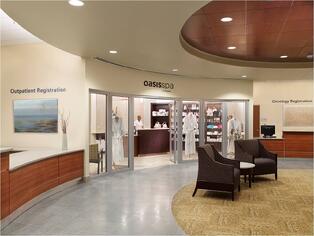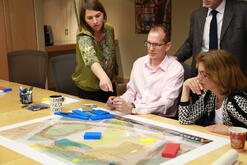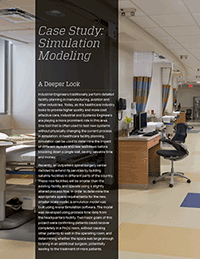Co-authored by Adrian Hagerty and Jessica Bellman, and featured in the 2015 Building Healthcare Magazine conference supplement.
As real estate investors and developers continue to look for ways to diversify their asset portfolios, healthcare tenancies are increasingly included in the discussion – often in places where one may never had foreseen until recently. In some cases the trend of providing healthcare services outside the walls of the traditional hospital has been accelerated by the Affordable Care Act (ACA). The related dawn of the Accountable Care Organization (ACO) payment structure is shifting the focus of healthcare providers to quality of outcomes rather than quantity of patients seen. Reimbursement structural reformation coupled with a vastly growing population of insured individuals will ultimately cause changes in any number of areas including expansion into retail locations, as medical groups and healthcare systems look to respond to these changes with effective strategies.
The Urban Land Institute continues to estimate that 64 million square feet of additional medical office space will be required during the next decade to meet the increased demand. While there is little debate regarding the acknowledgement of this trend, many questions remain. W ho will develop this space? Where will it be located? How will it be developed? What types of spaces are needed outside the walls of the hospital? Who has the investment money? How will the risk be managed? Who is willing to manage the risk?
ho will develop this space? Where will it be located? How will it be developed? What types of spaces are needed outside the walls of the hospital? Who has the investment money? How will the risk be managed? Who is willing to manage the risk?
Ever since the economic downturn from the last decade, conventional wisdom has pointed towards portfolio diversification as a way of managing risk. The concept of portfolio “diversification” can be applied to all investment ventures - but when applied to the real estate market – the goal comes with some inherent risks that are cause for pause. The uncertainty of venturing into unchartered waters can be unsettling at best. As already noted, there are many more questions than easy answers, but smart developers and healthcare providers will look for partners who have healthcare experience for guidance. Firms with proven track records that concentrate on the healthcare marketplace can limit risk and enhance outcomes with a “been there / done that” approach that will avoid the potholes, and steer ventures towards smooth pavement on the road to success.
Recently, leaders of two national firms sat on an industry panel to discuss the topic of repurposing existing office retail space into healthcare facility space - one representing the architectural design aspect and the other representing development, capital assistance and the long-term perspective. This once-unforeseen repositioning strategy has become a regular avenue in which to integrate healthcare into our everyday environmental fabric primarily through convenience and access. While this topic is clearly worthy of a deeper dive, there are some fundamental factors to be considered on the surface that will help developers and healthcare providers understand when it makes sense to (or not to) reposition existing assets for healthcare. The following outlines these factors, while also highlighting the keys to success once the decision is made to adaptively repurpose commercial space for healthcare use.
To “Build New” or to “Repurpose”?
Maybe this is not the question asked by Prince Hamlet, but it may be just as challenging to answer. The primary reasons to repurpose are directly related to the key factors of location and access. Healthcare providers increasingly seek to offer their services within established communities – close to existing shopping, schools, residences, offices and civic facilities. Often these established areas of activity have limited real estate available for greenfield development, so it is natural to look for existing assets for potential redevelopment. But the evaluation of suitability is not simply limited to matching square footage need to available square footage. The analysis is much more complex. From the perspective of both the landlord (and/or asset holder) and the prospective tenant (and/or buyer), it is vital that a mutual understanding is established that matches the unique qualities of the intended use to the technical qualities and capacities of the real estate asset. Ambulatory healthcare facilities more often include functions that were traditionally located in hospitals, including surgery, high-tech diagnostic imaging, urgent care, dialysis, etc. – all accompanied by a unique set of technical facility requirements. Some existing buildings can be readily adapted to meet the proposed functional requirements, but others may require such extensive remedial work that it ultimately does not make financial sense to move forward in an adaptive reuse format.
In addition to stronger technical facility requirements, healthcare facility uses require additional basic services that are often above and beyond what is typically provided within an existing commercial shell and its lot. One of many factors is convenient access and parking, which is essential for practically all uses but healthcare facilities more often than not will require covered entrances and more parking designated for patients. Parking a football field away from the door may be acceptable when visiting Wal-Mart, but it will create challenges when accessing an ambulatory care center. Attention should also be paid to the availability of natural light and its suitability for the adapted use. An old Circuit City with few to no windows will likely require significant alteration to its exterior to provide access to daylight and/or views to the exterior. Not only can the natural light be a cost benefit to utility savings but studies prove positive patient affects and outcomes based on natural and comfortable finishes, light and imagery.
In all cases, it is vital to engage qualified professionals who can review conditions and efficiently make feasibility recommendations based on field reviews of the facility and upon review of supporting record documentation of any given facility – answer the question, “To Build New or to Repurpose?”
Strategies for Success
 Let’s assume your organization has decided to move forward with the repurposing of an existing facility, upon completion of a deliberate feasibility study of an adaptive reuse option, and after exhibiting an appropriate level of due diligence. You are now in a great position to reap the benefits of adaptive reuse by saving time and money in the planning and execution of the development. Time is typically saved during the design phase because the (sometimes cumbersome) site planning and zoning approval processes are typically not applicable - or at least greatly reduced in scope. Construction time can be significantly reduced if the building shell can be used without major alteration. It all sounds very straightforward once you make the decision to repurpose a building for healthcare use, but seasoned professionals know that just as much intricacy is involved in a repurpose as there is a build-to-suit from the ground up. There are a few subtle (more granular) strategies that are worth noting and will enhance your ability to deliver a successful repurposing project:
Let’s assume your organization has decided to move forward with the repurposing of an existing facility, upon completion of a deliberate feasibility study of an adaptive reuse option, and after exhibiting an appropriate level of due diligence. You are now in a great position to reap the benefits of adaptive reuse by saving time and money in the planning and execution of the development. Time is typically saved during the design phase because the (sometimes cumbersome) site planning and zoning approval processes are typically not applicable - or at least greatly reduced in scope. Construction time can be significantly reduced if the building shell can be used without major alteration. It all sounds very straightforward once you make the decision to repurpose a building for healthcare use, but seasoned professionals know that just as much intricacy is involved in a repurpose as there is a build-to-suit from the ground up. There are a few subtle (more granular) strategies that are worth noting and will enhance your ability to deliver a successful repurposing project:
- Measure, Cut, Analyze - Repeat: Establish a baseline condition assessment report to define the existing building characteristics as a reference point that forms a mutual understanding for real estate changes and/or needs.

- Getting the measurements correct seems obvious, but far too often there can be disagreements regarding the exact square footage of a given space – especially within existing real estate assets. Investing in the detailed digital measurement of your facility can avoid such misunderstandings if providing indisputable area data developed by a third party.
- Thoroughly review and document existing conditions to identify required alterations and clearly define construction scope.
Seize the Moment: Capitalize on the repurpose venture as an opportunity for improvement in a number of ways:
- Enhance branding of your organization in what often will be a more visible and accessible location.

- Implement more efficient / lean processes into the operation of the new facility to reduce waste, improve outcomes and increase margins.
- Look to include retail opportunities that complement the healthcare services planned for the proposed facility.
- Use the new facility development as an opportunity to affiliate with a complementary or relative service to add more value to your patients and incorporate customer friendly practices into your operation.
Think Long Term: One aspect that makes healthcare tenancies unique is that the investment in the technical details of the facility creates an incentive for tenants to stay put for the long term.
- Incorporate sustainable design strategies that make “cents” for your facility. It’s not just about getting LEED points, but more about sensible applying design strategies that are consistent with the long term sustainability goals – and achievable in a manner that balances first time and long term operational costs.
- Plainly define energy goals and monitoring strategies to enhance ability to clarify such terms in any lease agreements.
- Establish development and operational standards that enhance the long term successful management of the facility.
Invest in Selecting the Best Team: Take the time needed to select a team with proven experience in delivering successful projects. Your time spent up front will pay off in the long term. The design, construction, development and project management team members should have proven experience in:
- Healthcare facility design and construction
- Private development facility design and construction
- Collaborative project delivery methodologies
- Relevant Regulatory Requirements
- Regional and Local Customs and Practices
From Beginning to End: Communication in all relationships is vital, and it stays true for those working together in healthcare development. All parties involved in the project should be present and fully informed from day one, until the project is completed. A few points to note that will help you implement and successfully accomplish a fully vested, knowledgeable and prepared team.
- Bring the Architect, Civil Engineer, Structural Engineer, General Contractor (and sub-contractors: MEP, Steel and whoever else may be applicable) together for the planning, timeline and organizational structure of the project.
- Have ONE lead. One team or point person that all parties involved and the client can speak to, receive updates and serve as the project leader.
- Continue to communicate with each member of the team throughout the project, having monthly or weekly meetings to go over updates, issues, needs and accomplishments.
There are no guarantees in healthcare or facility development. Clearly this applies to any venture that considers the repositioning of a real estate asset for a new healthcare use. While every endeavor comes with its own set of unique circumstances, experience has demonstrated that the application of the strategies outlined above can reduce your risk and increase the opportunity for successful outcomes – ultimately delivering a facility that can become a long term, productive asset to enhance any development portfolio, while providing access to valuable healthcare services in a growing marketplace.
Click on the image below to download a case study on how simulation can pinpoint best practice workflows prior to committing to overall building size and configuration.
This blog written by Adrian Hagerty, formerly Array's Chief Operating Officer.


